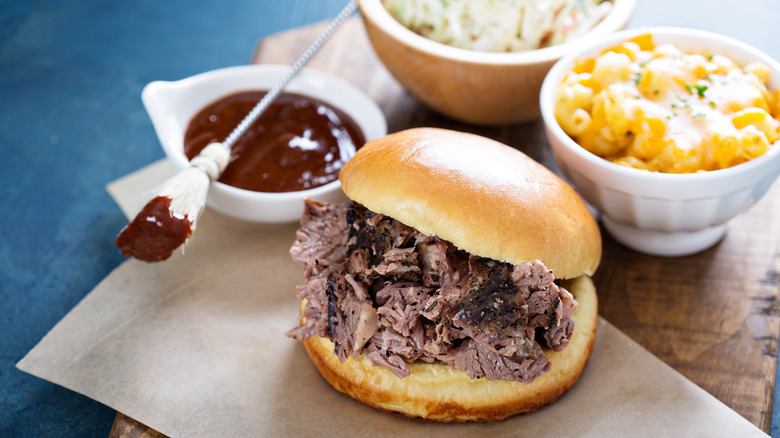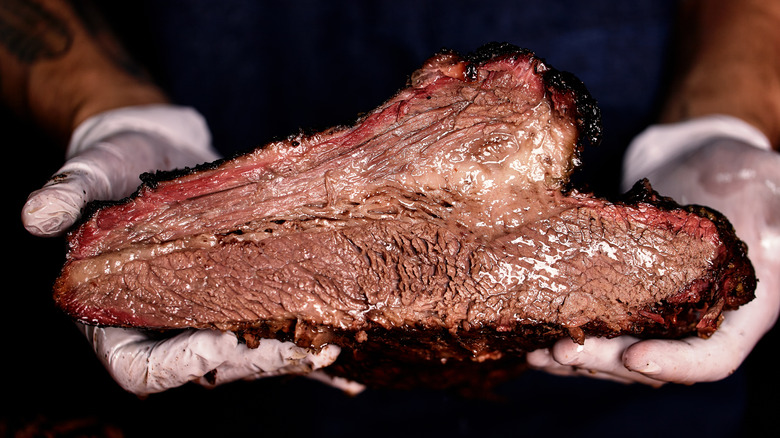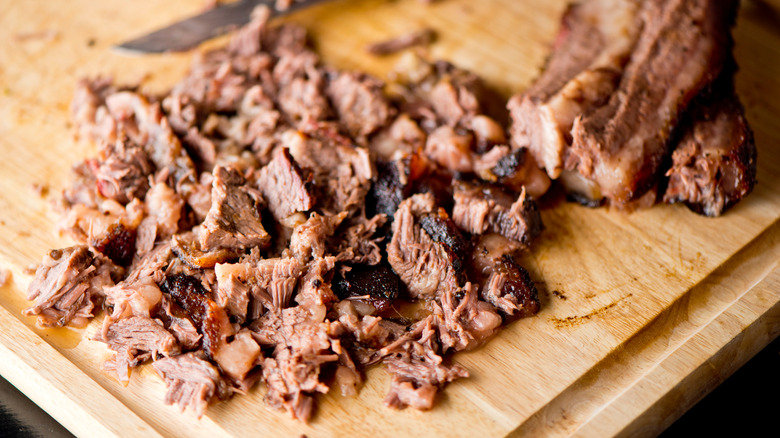The Best Way To Chop Brisket
There's a lot to know about when it comes to beef. Cows are big animals and are understandably complex once you break them down into their different groups of muscles for butchering.
The Best Stop says that the easiest way to break down this animal is in terms of its eight primal cuts. These are the eight largest divisions of the cow, and knowing whether your steak came from the loin or the flank will tell you more about your meat. One of those eight primal cuts is the brisket.
Traeger explains that the brisket is the lower chest section of the cow, and because it's a working muscle, it's full of connective tissue and fat. That might sound like a deterrent, but really it just means that this meat is perfect for slow cooking. The meat does well with long days spent in smokers for Texas BBQ brisket as well as in the curing process needed to make corned beef and pastrami. These cooking methods help loosen up the tough meat and add tons of flavor in the process.
One thing most folks don't think about when they first buy a brisket though is how they're going to cut it. It might seem like a simple process, but brisket calls for some special attention thanks to its unique anatomy.
What to know about brisket
The Kitchn points out that brisket is a meat that is most often broken into two sections. The larger section is called the flat and is, notably, flat. The other section is called the point. It has an odd shape and comes to a point. Some cuts of brisket won't even include the point because not everyone knows what to do with it, so it's best to buy from a butcher and know what you're getting if it's your first time handling a brisket.
Knowing the difference between these two sections is important for multiple reasons. Simply Meat Smoking says that the point is the more flavorful section of the brisket because it is loaded with fat and collagen that melts down during the slow cooking process. That means that it's going to have a different flavor from the flat even if it's cooked together. The Kitchn adds that the two sections' muscle fibers also run in different directions. This is important when it comes to slicing because cutting against the grain will make for more tender meat. So, even if you cook the whole brisket together, you'll need to separate the two sections to ensure that both are cut against the grain of the fibers.
Another option to avoid worrying too much about the grain is to go for a chopped brisket rather than sliced.
How to properly chop brisket
One of the great qualities of brisket is that it can be served up and portioned out in refined slices, or chopped up to dish out as a shredded topping or sandwich filling. Making that decision is a personal choice, but there are a few things to keep in mind.
First of all, when we talk about sliced versus chopped, Lifehacker explains that chopped usually means cutting something into large chunks or squares basically. They're larger than dicing or mincing, but usually, still bite size. Slicing however means that the meat or vegetables are cut into long, sometimes thin, slices. BBQ Host says that for more elegant dining experiences, those long slices will make for a better presentation. A big chopped-up mess of brisket though is perfect for sandwiches, and decking the meat out in a rich sauce. Simply Meat Smoking adds that a great way to have the best of both worlds is to slice the flat and chop the point because of its irregular shape and high-fat content.
To chop your brisket, The Kitchn recommends using a meat cleaver. This heavy blade will make quick work of chopping up the point, or the entire brisket. It's best to still cut against the grain, and simply run the cleaver over the meat until it's chopped into appropriately sized pieces.


